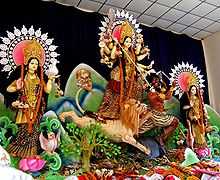Religion in Bangladesh
| Part of a series on the |
| Culture of Bangladesh |
|---|
|
People
|
|
|
Traditions
|
|
|
| Religion |
|
Art |
|
Literature History
Genres
Institutions Awards Writers
|
|
Music and performing arts |
|
Media
|
|
|
Monuments |
|
Islam is the largest Religion of Bangladesh; Muslims constitute 90.4% of the population, followed by Hindus, who constitute 8.2%, and Buddhists, Christians, those who practice other religions and those who do not are the remainders.[1] Religion has always been a strong part of identity, but this has varied at different times. A survey in late 2003 confirmed that religion is the first choice by a citizen for self-identification. According to a government-published article, atheism is extremely rare.[2]
Islam

Muslims constitute over 90 percent of the population.[4] Most Muslims in Bangladesh are Sunnis, but there is a small Shia community and an even smaller Ahmadiyya Muslim Community. Most of those who are Shia reside in urban areas. Although these Shias are few in number, Shia observance commemorating the martyrdom of Muhammad's grandson, Husain ibn Ali, is widely observed by the nation's Sunnis.[5]
The Muslim community in the Bengal region developed independent of the dominant Islamic trends in India. The preservation of pre-Islamic cultural elements from Buddhist and Hindu periods made the commitment to Islam uniquely Bangladeshi. Features of Bangladeshi Hinduism, which differed in some respects from Hinduism in other parts of South Asia, influenced both the practices and the social structure of the Bangladeshi Muslim community. In spite of the general personal commitment to Islam by the Muslims of Bangladesh, observance of Islamic rituals and tenets varies according to social position, locale, and personal considerations. In rural regions, some beliefs and practices tend to incorporate elements that differ from and often conflict with orthodox Islam.
Hinduism


Hinduism is the second largest religious affiliation in Bangladesh, covering approximately 10% of the population at the 2001 census.[6] In terms of population, Bangladesh is the third largest Hindu state of the world, after India and Nepal.[7]
In nature, Bangladeshi Hinduism closely resembles the forms and customs of Hinduism practised in the neighbouring Indian state of West Bengal, with which Bangladesh (at one time known as East Bengal) was united until the partition of India in 1947.
Buddhism

About 0.7% (or just over 1,000,000 people) of Bangladesh population adheres to the Theravada school of Buddhism.
In antiquity, the region of present-day Bangladesh was a center of Buddhism in Asia, and Buddhist civilization, including philosophies and architecture, travelled to Tibet, Southeast Asia and Indonesia from Bengal. The Buddhist architecture of Cambodia, Indonesia and Thailand, including the Angkor Wat Temple and the Borobudur vihara, are believed to have been inspired by the ancient monasteries of Bangladesh such as the Somapura Mahavihara.
Most of the followers of Buddhism in Bangladesh live in the South-Eastern region, especially in the Chittagong Hill Tracts, Chittagong and Comilla district. Most of the Buddhists of Chittagong Hill Tracts belong to the Chakma, Chak, Marma, Tanchungya and the Khyang, who since time immemorial have practiced Buddhism. Other tribals, notably those who practice animism, have come under some Buddhist influence, and this is true in the case of the Khumi and the Mru, and to a lesser extent in the case of the other tribes. Buddhism is also practiced by the Bengali-speaking Baruas, who are almost exclusively Buddhist and are concentrated heavily in the Chittagong area.
Christianity
Christianity arrived in what is now Bangladesh during the late sixteenth to early seventeenth centuries AD, through the Portuguese traders and missionaries.
Christians account for approximately 0.6% of the total population. Roman Catholicism is dominant; the remaining Christians are predominantly Protestant.
Law, religion, and religious freedom
Although initially Bangladesh opted for a secular nationalist ideology as embodied in its Constitution, the principle of secularism was subsequently replaced by a commitment to the Islamic way of life through a series of constitutional amendments and government proclamations between 1977 and 1988. The Constitution establishes Islam as the state religion but provides for the right to practice—subject to law, public order, and morality—the religion of one's choice.[8] The Government generally respects this provision in practice; however, some members of the Hindu, Christian, Buddhist, and Ahmadiyya communities experience discrimination. The Government (2001-2006), led by an alliance of four parties (Bangladesh Nationalist Party, Bangladesh Jamaat-e-Islami, Islami Oikya Jote and Bangladesh Jatiyo Party) banned the Ahmadiyya literatures by an executive order.
Family laws concerning marriage, divorce, and adoption differ depending on the religion of the person involved. There are no legal restrictions on marriage between members of different faiths.
References
- ↑ "The World Factbook". Cia.gov. Retrieved 2013-08-16.
- ↑ "Bangladesh". State.gov. Retrieved 2013-08-16.
- ↑ Know Bangladesh | Bangladesh National Web Portal
- ↑ "The World Factbook". Cia.gov. Retrieved 2013-08-16.
- ↑
- ↑ "Bangladesh". State.gov. Retrieved 2013-08-16.
- ↑ "[Analysis] Are there any takeaways for Muslims from the Narendra Modi government?". DNA. 27 May 2014. Retrieved 31 May 2014.
- ↑
![]() This article incorporates public domain material from websites or documents of the Library of Congress Country Studies.
This article incorporates public domain material from websites or documents of the Library of Congress Country Studies.
| ||||||||||||||